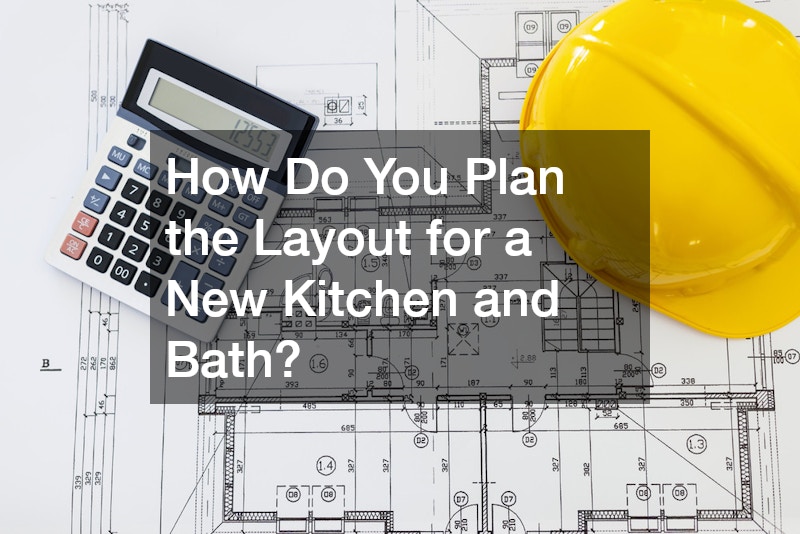
Renovating your kitchen and bathroom at the same time may seem like a bold move, but it can lead to more efficient project timelines, cohesive designs, and cost savings. These two spaces are among the most used in any home and upgrading them simultaneously can dramatically improve both form and function. While the logistics may require careful planning, the benefits often outweigh the challenges—especially when working with experienced professionals like a trusted kitchen contractor or a seasoned bathroom remodel contractor.
This comprehensive guide explores the advantages of taking on a joint renovation, including budgeting, design considerations, material choices, and selecting the right team of professionals. Whether you’re planning a modern update or a full-scale overhaul, this approach can make the most of your investment while enhancing your home’s comfort and resale value.
What Are the Benefits of Integrating a New Kitchen and Bath Project?

Cost Efficiency
Merging your kitchen and bathroom upgrades into one project can significantly reduce overall costs. Hiring a kitchen contractor and bathroom remodel contractor at the same time allows for better package deals on labor, permits, and even materials. Shared work like plumbing rerouting, demolition, or electrical rewiring becomes more efficient and cost-effective when bundled together. Moreover, using the same painting contractor, flooring service, or other trade professionals across both spaces often leads to discounted rates or reduced mobilization fees.
Time Management
Coordinating two renovations at once streamlines scheduling. It minimizes disruptions to your daily life by consolidating construction time. For example, if you’re living in the home during the renovation, you may need to relocate only once, rather than for two separate projects months apart. A well-organized timeline, established with your kitchen contractor and bathroom remodel contractor, helps to move the project along smoothly.
Design Harmony
Taking on a kitchen and bathroom renovation together allows for a consistent design language throughout your home. Working with the same interior painting service ensures color palettes flow seamlessly between spaces. Similarly, coordinating flooring service providers allows you to use the same materials, such as engineered wood flooring, in both areas—providing continuity in tone, texture, and style. A unified design improves not only aesthetics but also overall functionality.
Increased Home Value
Renovated kitchens and bathrooms yield high returns on investment. Potential buyers often focus on these spaces when evaluating a property. By upgrading both simultaneously, you maximize your home’s marketability. Whether you’re installing a new water heater or enhancing finishes, these updates reflect a well-maintained, move-in-ready home that justifies a higher asking price.
Streamlined Contractor Workflow
Professionals like commercial contractors and residential HVAC companies benefit from consolidated scopes of work. These efficiencies often lead to better project coordination and fewer delays. When everyone—from your kitchen contractor to your plumbing team—is working from the same schedule and plan, miscommunications and scheduling gaps are less likely to occur. This integrated approach ensures that overlapping tasks, such as ventilation updates or fixture installations, are done right the first time.
How Much Should You Budget for a New Kitchen and Bath?

Average Cost Estimates
A mid-range kitchen renovation typically ranges from $25,000 to $50,000, while a standard bathroom remodel may fall between $10,000 and $25,000. When combined, the total project cost often falls between $35,000 and $70,000, depending on scope, finishes, and local labor rates. Choosing a package deal from a reputable kitchen contractor or bathroom remodel contractor may bring those figures down slightly, especially when using the same team across both rooms.
Factors Influencing the Cost
Several factors influence total renovation costs. The size and complexity of each room, your choice of finishes, and the need for plumbing or HVAC upgrades all contribute. Replacing flooring with engineered wood flooring, adding new lighting systems, or updating appliances and water heater systems will impact your budget. The use of premium finishes or specialty work by commercial contractors may also increase costs.
Budgeting Tips
To keep your project within scope, create a detailed budget that includes line items for demolition, materials, labor, and contingencies. Work with professionals like a painting contractor or flooring service provider to get accurate estimates and avoid surprises. Consider phasing your project or selecting cost-effective materials without compromising quality.
Financing Options
Many homeowners finance renovations through home equity lines of credit, renovation loans, or special contractor financing programs. Some kitchen and bathroom remodel companies offer in-house financing to help spread out the cost. Discuss these options with your kitchen contractor to determine the best path forward based on your financial goals.
Potential Cost Overruns
Unforeseen issues like plumbing problems or electrical code violations can lead to cost overruns. That’s why it’s essential to work with licensed professionals such as local plumbers and residential HVAC companies. These experts can identify risks early and help you avoid costly mid-project changes. Always leave room in your budget—around 10 to 15%—to account for the unexpected.
What Design Trends Should You Consider for a New Kitchen and Bath?
Popular Styles and Themes
Whether your taste leans toward modern minimalism or cozy farmhouse, aligning the themes between your kitchen and bathroom creates visual harmony. Neutral color palettes, clean lines, and mixed materials are currently popular, as are spaces that blend comfort with function.
Color and Material Choices
Light cabinetry, bold hardware, and natural elements are trending. Engineered wood flooring continues to grow in popularity due to its durability and versatile look. Coordinating countertops, backsplashes, and paint colors across both rooms can bring cohesion and elegance to your design.
Sustainable Design Practices
Eco-conscious renovations are in high demand. Homeowners are opting for energy-efficient appliances, water-saving fixtures, and low-VOC paint from their interior painting service. Incorporating sustainable elements may even qualify your project for local tax incentives or rebates.
Technology Integration
Smart home technology is rapidly becoming standard. From smart thermostats installed by residential HVAC companies to touchless faucets and lighting automation, these features offer convenience and efficiency. Integrating tech into both your kitchen and bath improves usability and future-proofs your home.
Storage Solutions
Well-designed storage is critical in both spaces. Pull-out pantry systems, under-sink organizers, and built-in bathroom niches enhance function without compromising aesthetics. Planning these elements simultaneously ensures consistent materials and finishes, which adds to the overall polish of the renovation.
How Do You Choose the Right Professionals for a New Kitchen and Bath?
Finding Qualified Contractors
The success of your project hinges on the team you hire. Seek out experienced kitchen contractors and bathroom remodel contractors who specialize in home renovations. Ask for referrals, check portfolios, and verify licenses before committing.
Evaluating Designer Credentials
If you plan to use an interior designer, look for those with certifications from recognized institutions. Designers familiar with both kitchen and bath planning will help maintain consistency and streamline the process.
Vetting for Reputation and Reliability
Online reviews, industry awards, and Better Business Bureau ratings are good indicators of quality. Look for professionals who are responsive, transparent, and willing to provide written estimates. A well-reviewed painting contractor or flooring service provider will likely deliver better outcomes than one with little to no track record.
Understanding Contractual Agreements
Always insist on a formal contract that outlines the scope of work, timelines, materials, payment schedules, and warranties. The more detailed the contract, the less chance for confusion or disputes later. Collaborate with your kitchen contractor and other vendors to ensure all expectations are documented.
Collaborating Effectively with Professionals
Strong communication ensures your vision is realized. Share inspiration photos, provide feedback early, and maintain regular check-ins. Whether you’re choosing a new engineered wood flooring or coordinating with local plumbers, staying engaged throughout the process helps ensure quality and satisfaction.
What Permits Might Be Required for a New Kitchen and Bath?

Understanding Local Regulations
Every municipality has its own building codes. Renovating your kitchen and bathroom together typically requires permits for plumbing, electrical, and structural changes. Familiarize yourself with local regulations early in the planning process.
Types of Permits
Depending on your project, you may need mechanical, plumbing, and electrical permits. Structural modifications or moving walls may require additional documentation and inspection. A seasoned kitchen contractor or commercial contractor can guide you through these requirements.
Application Process Overview
Permit applications usually involve submitting detailed plans and contractor credentials to your local building department. Approval times vary, so start this process early to avoid delays.
Timeline for Permit Approval
Permit approval can take anywhere from a few days to several weeks. Factor this into your project timeline and coordinate closely with your contractors to ensure compliance.
Dealing with Inspection Requirements
Once permits are issued, your project will likely require inspections at key stages. Working with licensed professionals like residential HVAC companies or local plumbers ensures your installation will pass code and reduce the chance of needing costly rework.
How Long Does It Take to Complete a New Kitchen and Bath?
Typical Timeframes for Each Room
A standard kitchen renovation may take six to eight weeks, while a bathroom remodel might take four to six weeks. When done together, timelines often overlap, shaving a few weeks off the combined duration.
Factors Influencing Project Duration
Custom cabinetry, special-order materials, or unexpected structural issues can extend the timeline. Clear communication and experienced project management are essential for keeping things on track.
Strategies to Expedite the Process
Ordering materials early, pre-selecting finishes, and working with well-coordinated crews like a flooring service and painting contractor can help avoid unnecessary delays.
Potential Delays and Solutions
Permitting issues, material shortages, or weather delays (for exterior work) can slow progress. Building in flexibility and having backup options ready can mitigate the impact of these delays.
Tips for Staying on Schedule
Regular project meetings, detailed timelines, and proactive contractor communication all help maintain momentum. Staying involved as a homeowner also encourages accountability and swift decision-making.
What Materials Are Best for a New Kitchen and Bath?
Countertops and Cabinetry
Quartz, granite, and solid-surface countertops remain popular for their durability and look. Cabinetry with soft-close features and smart storage adds both value and functionality.
Flooring Options
Engineered wood flooring is ideal for kitchens due to its moisture resistance and upscale look. In bathrooms, consider luxury vinyl tile or porcelain for water resistance.
Plumbing Fixtures and Finishes
Choose quality fixtures from reputable brands to ensure long-term performance. Local plumbers can recommend systems that match your home’s water pressure and compatibility.
Lighting and Electrical
Layered lighting—ambient, task, and accent—is critical in both spaces. Coordinate with electricians and residential HVAC companies to optimize comfort, safety, and energy use.
Maintenance and Durability Considerations
Select materials that are easy to clean and maintain. For example, semi-gloss finishes from an interior painting service are more durable in humid environments than matte finishes.
How Can a New Kitchen and Bath Enhance Your Lifestyle?
Improved Functionality
Upgrading outdated layouts with thoughtful design can make cooking, bathing, and cleaning far easier and more enjoyable.
Enhanced Aesthetics
Modern finishes, coordinated color palettes, and sleek fixtures elevate the visual appeal of your home, making it feel fresh and luxurious.
Better Family Interaction
Open layouts and smart storage encourage interaction and improve daily routines. These spaces become more inviting and communal.
Energy Efficiency
Installing energy-efficient lighting, ventilation, and a new water heater can lower utility bills and reduce your carbon footprint.
Increased Comfort and Convenience
Ergonomic design, proper lighting, and climate control all contribute to a more comfortable living experience for everyone in the household.
How Do You Plan the Layout for a New Kitchen and Bath?

Assessing Your Existing Space
Start by evaluating what’s working and what’s not. Take detailed measurements and note pain points that need resolving.
Designing with Purpose
Each element—appliances, cabinetry, fixtures—should serve a purpose. Form should always follow function.
Optimizing for Flow and Accessibility
Ensure smooth traffic patterns and consider accessibility features like grab bars, non-slip flooring, and wide entryways.
Utilizing 3D Modelling Tools
Design software helps you visualize the finished space, experiment with layout options, and make informed decisions before construction begins.
Tips for Finalizing Your Layout
Collaborate with your kitchen contractor and bathroom remodel contractor to refine your plans and ensure compliance with code and safety standards.
What Common Mistakes Should Be Avoided When Undertaking a New Kitchen and Bath Project?
Overlooking Your Budget
Failure to plan financially can derail even the best designs. Stick to your budget and monitor spending throughout.
Ignoring Functionality for Aesthetics
Beautiful spaces must still be practical. Prioritize layout and ease of use over trendy finishes that may not suit your lifestyle.
Skipping Professional Help
DIY can be tempting, but complex systems like HVAC or plumbing demand professional attention. Engage commercial contractors, residential HVAC companies, or local plumbers as needed.
Neglecting Future Needs
Design with longevity in mind. Consider how your needs might evolve and plan for aging in place, growing families, or resale value.
Underestimating Time and Complexity
Renovations rarely go exactly as planned. Expect surprises and be flexible. A well-prepared team makes all the difference.
Final Thoughts
Renovating your kitchen and bathroom at the same time is a smart investment that can save time, reduce costs, and deliver a unified aesthetic across your home. From choosing the right kitchen contractor and bathroom remodel contractor to selecting high-performance materials and staying on schedule, careful planning is key. When executed well, this dual-room upgrade enhances your daily life and positions your home for long-term value. By partnering with the right professionals and approaching the process strategically, you can turn your vision into a successful, rewarding reality.





